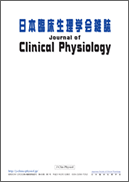Volume 54, Issue 5
Journal of Clinical Physiology
Displaying 1-6 of 6 articles from this issue
- |<
- <
- 1
- >
- >|
Review Article
-
2024Volume 54Issue 5 Pages 143-151
Published: December 01, 2024
Released on J-STAGE: April 12, 2025
Download PDF (512K) -
2024Volume 54Issue 5 Pages 153-156
Published: December 01, 2024
Released on J-STAGE: April 12, 2025
Download PDF (1125K) -
2024Volume 54Issue 5 Pages 157-161
Published: December 01, 2024
Released on J-STAGE: April 12, 2025
Download PDF (2087K) -
Respiratory Muscle Training: Current Status and Future Prospects: Expansion into the Field of Sports2024Volume 54Issue 5 Pages 163-175
Published: December 01, 2024
Released on J-STAGE: April 12, 2025
Download PDF (3991K) -
2024Volume 54Issue 5 Pages 177-185
Published: December 01, 2024
Released on J-STAGE: April 12, 2025
Download PDF (807K)
Original Article
-
2024Volume 54Issue 5 Pages 187-194
Published: December 01, 2024
Released on J-STAGE: April 12, 2025
Download PDF (444K)
- |<
- <
- 1
- >
- >|
